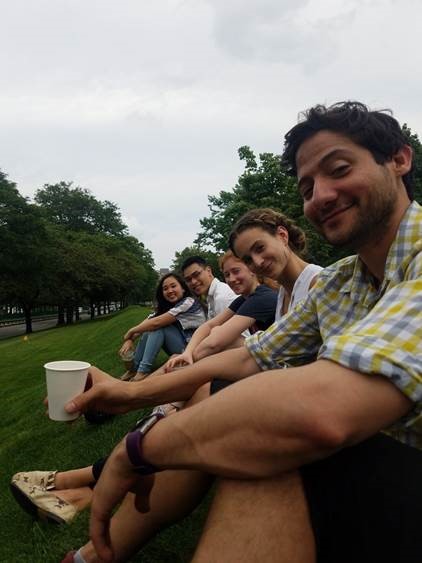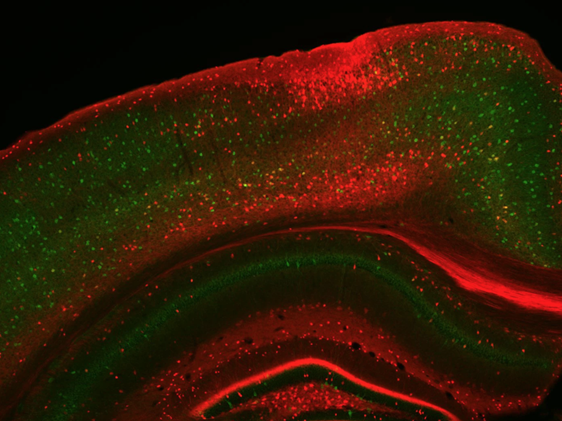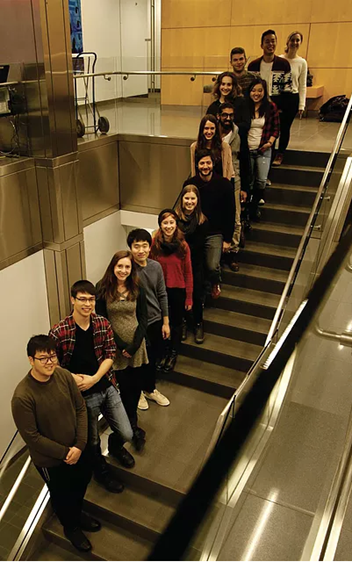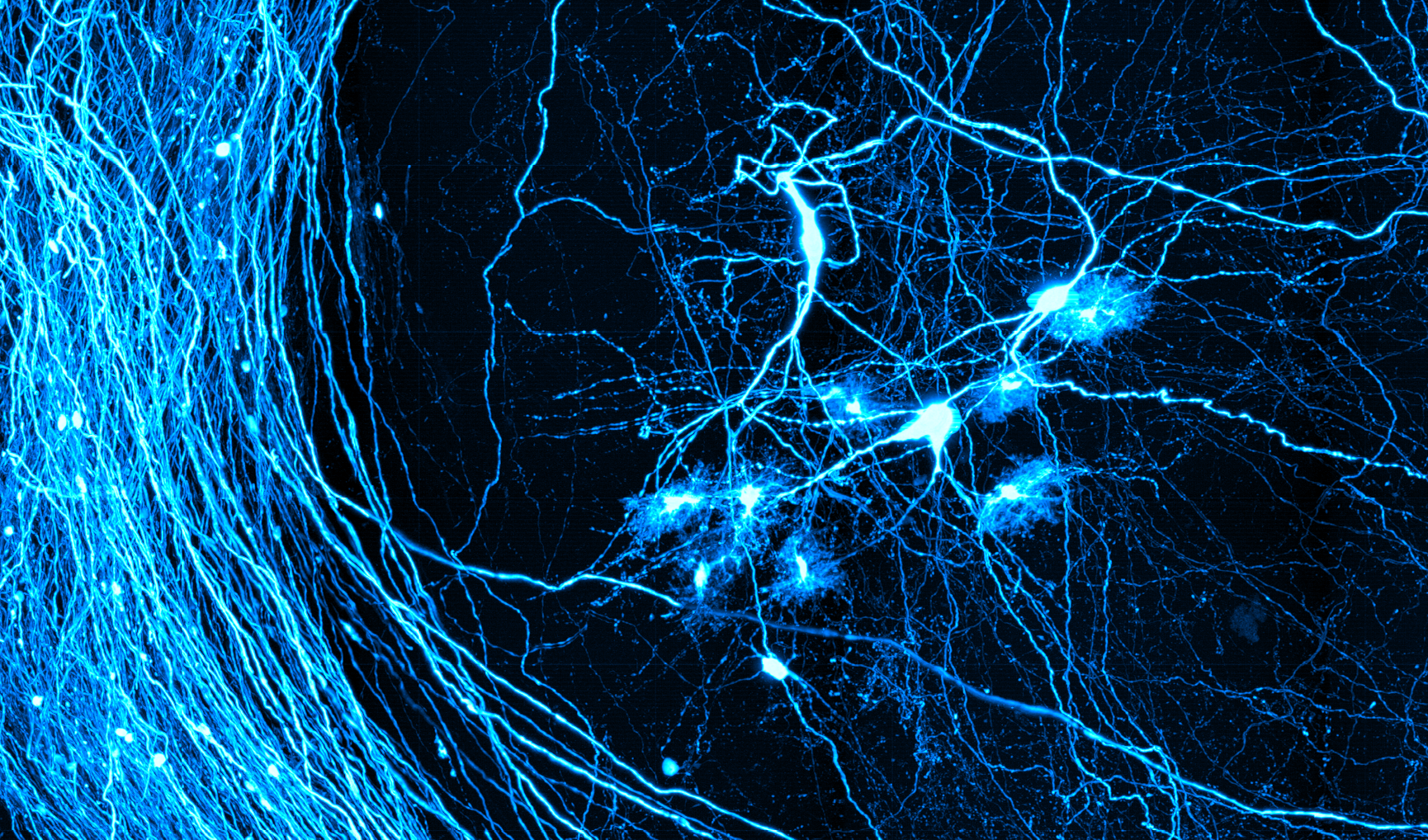Alberto Cruz-Martín Lab: Fostering the Future of Neuroscience
Led by Alberto Cruz-Martín, Assistant Professor of Biology, the Cruz-Martin Lab is seeking a better understanding of the cellular and molecular mechanisms that guide the development of synaptic connections in the neocortex. The lab launched in 2015, when Alberto joined the faculty at BU.
 Alberto traces his interest in neuroscience to his early college days in Puerto Rico. Born in San Juan, Puerto Rico, where he also enjoyed surfing, discovering hidden beaches and watching old movies, he was fortunate to have had an inspiring and influential science mentor. Guided by his mentor, he was able to do undergraduate research in one of a handful of laboratories at the University of Puerto Rico, Río Piedras. His earliest training using electrophysiological recordings aimed at understanding how excitation and inhibition are arranged within small local microcircuits and how the specific molecular makeup of a synapse determines its synaptic release properties. He also investigated a calcium-binding protein, Neuronal Calcium Sensor-1 (NCS-1), whose role in the mammalian nervous system was unknown at that time.
Alberto traces his interest in neuroscience to his early college days in Puerto Rico. Born in San Juan, Puerto Rico, where he also enjoyed surfing, discovering hidden beaches and watching old movies, he was fortunate to have had an inspiring and influential science mentor. Guided by his mentor, he was able to do undergraduate research in one of a handful of laboratories at the University of Puerto Rico, Río Piedras. His earliest training using electrophysiological recordings aimed at understanding how excitation and inhibition are arranged within small local microcircuits and how the specific molecular makeup of a synapse determines its synaptic release properties. He also investigated a calcium-binding protein, Neuronal Calcium Sensor-1 (NCS-1), whose role in the mammalian nervous system was unknown at that time.
Eager to expand his expertise in imaging techniques and to incorporate the study of brain disorders in mouse models, he joined Dr. Carlos Portera-Cailliau’s laboratory while working on his PhD. at UCLA. There, he used in vivo two-photon microscopy imaging through cranial windows in neonates to show that in the mouse model of fragile X syndromes (FXS) spines are abnormally unstable and there is an overabundance of immature protrusions. Alberto recounts, “I still remember seeing my first filopodia moving in vivo in the intact brain, it blew my mind that synapses in the brain were dynamic and I wanted to understand how the motility of these structures regulated synaptic formation.”
 After receiving his Ph.D., he joined Dr. Anirvan Ghosh’s laboratory in September 2010 to further pursue his interests in linking the function of specific circuits to sensory processing and perception. Through his research experiences, he says, “with the right tools in my hand I proceeded to do a very challenging experiment that was needed to finish my story, to record thalamocortical axons in vivo in the visual cortex. I have failed miserably many times in my life but this time I got lucky and my experiments worked. I showed for the first time pretty axonal boutons activating in response to a visual stimulus! Not thinking too much about what I had accomplished at the time, it later sank in my mind that I also made an important contribution in our understanding of sensory perception.”
After receiving his Ph.D., he joined Dr. Anirvan Ghosh’s laboratory in September 2010 to further pursue his interests in linking the function of specific circuits to sensory processing and perception. Through his research experiences, he says, “with the right tools in my hand I proceeded to do a very challenging experiment that was needed to finish my story, to record thalamocortical axons in vivo in the visual cortex. I have failed miserably many times in my life but this time I got lucky and my experiments worked. I showed for the first time pretty axonal boutons activating in response to a visual stimulus! Not thinking too much about what I had accomplished at the time, it later sank in my mind that I also made an important contribution in our understanding of sensory perception.”
In launching his lab at BU, he is expanding upon his early successes. His start at BU coincided with the submission of the NSF Research Training (NRT) grant “Understanding the Brain: Neurophotonics,” which BU was fortunate to obtain in 2016. The grant has been instrumental in helping to establish the foundation of his lab at BU. As he says, “the NSF grant has really made a difference in creating a more connected community between all the systems neuroscience labs at BU.” It has also created a collegiate environment where postdocs and graduate students can talk about their science. Lab members Lisa Kretsge and Ashley Comer are NRT Trainees and have already presented their work at various science meetings including The Cold Spring Harbor Meeting: Molecular mechanisms of Neuronal Connectivity.
Lisa Kretsge is a third year Ph.D. student in the Graduate Program for Neuroscience. She earned her B.A. in Neuroscience and Behavior from Vassar College in 2014. After graduating, she spent two years as a technician in Dr. Joshua Gordon’s laboratory at Columbia University. She used in vivo electrophysiology, optogenetics, and behavioral testing to study the neural circuitry involved in stress and depression-like behaviors in mice. In the Cruz-Martín lab, she uses in vivo 2-photon calcium imaging to better understand whether exposure to early life stress alters network-level activity in the developing prefrontal cortex. The NSF NRT Neurophotonics program has fostered a collaborative research community, which facilitated her work on a project with a photonics-focused laboratory. Additionally, the traineeship includes coursework and Boot Camp, which have provided Lisa with more practice explaining her work to scientifically diverse audiences and have made her more comfortable discussing the optics involved in her research.
Ashley Comer, also a NRT Trainee and member of Alberto’s lab, is a fourth-year graduate student in the Graduate Program for Neuroscience. She graduated from the University of Houston in 2015 with a B.S. in Psychology and a minor in Biology. As an undergraduate, Ashley participated in research by working in both a behavioral neuroscience lab and a molecular pharmacology lab. She was first introduced to neurophotonics as a first-year graduate student in Alberto Cruz-Martin’s lab where she learned how to use two-photon microscopy to image pyramidal neurons in vivo during development in mice. For her dissertation, she is studying the development and plasticity of neural circuits and how these processes are perturbed in diseased states. Specifically, she studies the role of a schizophrenia-linked immune molecule, complement component 4, in the developmental wiring of prefrontal circuits. The NSF NRT Neurophotonics community has challenged Ashley to perceive her project from multiple perspectives, ultimately strengthening the project through an interdisciplinary approach to the research. Additionally, the NSF NRT has fostered a larger community of people which has allowed Ashley to communicate her research with those she would not have encountered otherwise.
Tushare Jinadasa, a postdoctoral research fellow in Alberto’s laboratory, received his PhD in Physiology from McGill University studying neuron firing in relation to pH regulation during metabolic shifts associated with ischemia. He then spent time working as a microscopy specialist at McGill University’s Advanced BioImaging Facility, where he continued to study the impact of pH, examining its compartmentalization and impact on synaptic plasticity at the CERVO Brain Research Centre in Quebec City. In the Cruz-Martín laboratory, he is taking a vertical approach to studying the physiology and pathophysiology of cortex. A portion of his research uses optical tools to elucidate social and cognitive circuitry of the cingulate cortex. The remainder of his work focuses on the connectivity, behavioral and functional changes of the prefrontal cortex in association with schizophrenia.  These projects use advanced in vivo imaging techniques but also leverage biochemical techniques to examine cellular and molecular mechanism. As a member of Boston University Neurophotonics Center, Tushare is involved with training and teaching; lecturing on the topic of fluorescent indicators as tools in neuroscience.
These projects use advanced in vivo imaging techniques but also leverage biochemical techniques to examine cellular and molecular mechanism. As a member of Boston University Neurophotonics Center, Tushare is involved with training and teaching; lecturing on the topic of fluorescent indicators as tools in neuroscience.
The Cruz-Martín lab is highly engaged with the Neurophotonics Community. In addition to the support and professional development that he, his students, and postdoctoral researchers have received through the Biology Department and Graduate Program for Neuroscience, his lab has the support of many groups at Boston University. Alberto and all of his researchers are highly engaged in programs associated with all of these groups and are excited to highlight the lab and some of the members who are connected closely with the NRT program and the Neurophotonics Center.
